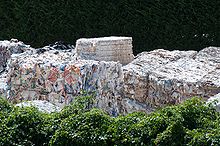Waste paper
Waste paper is paper waste that is collected in households or businesses. It is for the production of recycled paper , newsprint and other products made of paper such as cardboard boxes used.
collection
Waste paper is collected in waste paper collection containers or in waste paper bins, collected by the municipality or by a company commissioned by the municipality or by private waste paper disposal companies in private households or businesses (so-called private or commercial waste disposal sites) and delivered to processing companies. It should be as free from rejects as possible . In some communities, the waste paper is also collected by associations, schools or churches and then sold on to recycling companies.
The following collection systems have proven themselves:
- in the commercial sector: baling presses, depot containers, press containers, emptying containers, lattice boxes.
- In the household sector (a distinction is made between pick-up and delivery systems): depot containers, bundle collection, compressed garbage trucks, sack systems, monotons, recycling yards.
Due to the high demand for waste paper (a ton of the bulk type "mixed waste paper" is worth around 55 euros), more and more private waste disposal companies pushed into the waste paper market until mid-2008 and offered households free "blue bins" because, according to the Federal Association, they could be used Secondary raw materials and disposal (bvse) 20 to 30 percent more waste paper can be collected than with the bundle or container collection.
The municipal authorities often questioned whether the erection of the buoys is legally permissible. Therefore, a large number of municipalities and districts had issued prohibition orders, but these were often rejected as unlawful by the competent courts, so that it could be assumed that the collection of waste paper by commercial companies from private households was legally permissible. In June 2009, however, the Federal Administrative Court ruled that there is a “fundamental responsibility of the public waste disposal authorities” for waste paper and that citizens should not entrust private competitors with the collection of their waste paper. After the Federal Administrative Court had ruled, the Hanover Administrative Court confirmed in January 2010 that municipalities can prohibit collection (e.g. also private waste paper collections).
In the course of the worsening outbreak of the financial crisis in autumn 2008, the situation changed suddenly. According to the Euwid industry service, the average price for so-called mixed bales fell from around 100 euros to just 5 to 15 euros per ton. Some dealers even set the sale price to zero.
As a result of increasing demand on the one hand and the closure of capacities on the other, the price for a ton of mixed waste paper finally rose again significantly to 85 euros in March 2010, accompanied by noticeably increased delivery times for cardboard.
With a recycling rate of 72%, so much waste paper was separated, collected and made available for paper production in Europe in 2012 as nowhere else in the world.
Sorting

The sorting of waste paper is an important prerequisite for providing the paper industry with the qualities of waste paper it needs. The aim is on the one hand to remove the non-paper substances from the groupage, and on the other hand to put together defined types of waste paper that are in demand by the paper industry. Sorting takes place manually or partially automatically and ultimately represents quality assurance before the used paper is handed over to the paper mill.
The manufacture of the various types of recovered paper is based on the “List of European standard types and their qualities” drawn up by the paper industry and the suppliers of recovered paper. This list describes in the European standard EN 643: 2014-05 95 types of waste paper in their composition and quality. The number of standardized grades is constantly increasing, as paper mills develop techniques to process previously unusable qualities.
history
The first process for recycling waste paper was invented in 1774 by Göttingen university professor Justus Claproth , in which the printing ink was completely washed out of the printed paper and new paper was made from it. This process was then used for the first time by the paper mill Schmidt in Klein Lengden . The so-called de-inking process, which is based on the principle of flotation , is now the standard procedure in the recycling of printed products.
See also
- Waste paper usage rate
- Waste paper return rate
- Waste paper volume
- Waste paper stock
- Interest group for paper raw materials
- Waste
- Paper recycling
literature
- Jürgen Blechschmidt: waste paper. Regulations - recording - processing - machines and systems - environmental protection, Hanser, Munich 2011, ISBN 978-3-446-42616-0 .
Web links
- Mandl / Stuhlbacher / Koinigg / Kautsch / Hengsberger: Fundamental studies on sprayed-on cellulose insulation layers for external facades . Graz 2001. (PDF; 2.4 MiB; see in particular section 2.5.4. Waste paper recycling)
- Waste paper ( Memento from April 11, 2010 in the Internet Archive ) - Document of the Bavarian State Office for the Environment (PDF; 56 KiB; accessed December 2, 2009)
Individual evidence
- ↑ As at: 08/2008, source: EUWID Recycling and Disposal
- ↑ Blue paper bin .
- ^ Report in Recycling Magazin. April 2, 2008, accessed January 22, 2019 .
- ↑ Municipalities win in the waste paper war before federal court. In: Welt Online. June 19, 2009. Retrieved June 20, 2009 .
- ^ Order of the Hanover Administrative Court of February 17, 2010, Az. 12 B 5464/09.
- ↑ Carsten Dierig and David Schraven : Dealers stay seated on their scrap. In: Welt Online. November 13, 2008, accessed November 19, 2009 .
- ↑ ftd.de: Recovered paper bottleneck: Cardboard is becoming scarce and expensive ( Memento from April 15, 2010 in the Internet Archive ) from April 13, 2010.
- ↑ EUWID No. 49.2013 of December 3, 2013, p. 29.



